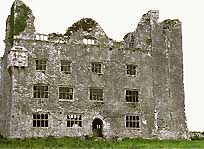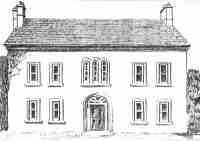Other Gaelic women
The lives of Lady Agnes Campbell, her daughter Finola MacDonnell (Iníon Dubh) and grand-daughter Nuala Ní Dhomhnaill illustrate several aspects of Ulster history and women's experience in sixteenth and seventeenth century Ireland.
Lady Agnes Campbell was a powerful and wealthy Scottish woman with a dowry of 1,200 mercenary troops, the result of unemployment in Scotland at the time. These troops wearing kilts were called 'redshanks'. They were a desirable asset for a sixteenth century Ulster chieftain and the Gaelic custom of coyne and livery enabled them to be lodged with his subjects, though Lady Agnes would maintain their loyalty. When Shane O'Neill killed her Scottish husband,
|
... Lady Agnes avoided a threatened marriage with the victor, eventually bestowing her hand on Turlough Luineach, Shane's successor as Great O'Neill of Tyrone, bringing with her a dowry of some 1,200 Scottish mercenary troops.
Katherine Simms in Women in early modern Ireland, Dublin 1991.
|
The marriage of her daughter Finola MacDonnell (Iníon Dubh) to an O'Donnell of Tír Conaill in 1569 created a link between the O'Neills and the O'Donnells. Iníon Dubh also brought a dowry of mercenary troops to her marriage. She used them to ensure the succession of her son, Red Hugh O'Donnell after he escaped from four years imprisonment by the English in Dublin Castle. Iníon Dubh was denounced by her enemies for ruthless plotting and intrigue but praised by her friends for political and military advice and for the maintenance of her troops.
|
It was an advantage that she came to the gathering, for she was the head of advice and counsel of the Cenél Conaill, and though she was calm and very deliberate and much praised for her womanly qualities, she had the heart of a hero and the mind of a soldier ... She had many troops from Scotland, and some of the Irish at her disposal and under her control and in her own hire and pay constantly, and especially during the time that her son [Aodh Rua] was in prison and confined by the English.
Lughaidh O'Cléirigh, quoted by Katherine Simms, 'Women in Norman Ireland' in Margaret MacCurtain & Donncha Ó Corráin, Women in Irish society: the historical dimension, Dublin, 1978, p.18.
|
Iníon Dubh's daughter Nuala Ní Dhomhnaill was 'married off' to her cousin Niall Garbh O'Donnell to console him for not being made chieftain of the O'Donnells. She deserted him and their children when he supported the English against her brothers and was amongst those who departed from Lough Swilly in 'the Flight of the Earls'. Nuala was a cultured woman and she travelled widely struggling for financial support from Continental sources and for the protection and reinstatement of her nephew, the heir to the O'Donnells.
Her rejected husband Niall Garbh O'Donnell was implicated in a rebellion by her mother, Iníon Dubh and spent the rest of his life in the Tower of London while Iníon Dubh herself received 600 acres of land in the plantation of Ulster.
|
Máire Rua MacMahon [1615-1686].
When Máire Rua McMahon married Conor O'Brien she was already a young widow and brought a dowry of £1,000. They had eight children and made a splendid home by extending their castle at Leamaneh in the Burren in Co. Clare. However Cromwellian forces killed Conor in 1651 and occupied the castle.
Máire's subsequent marriage to a Cromwellian soldier helped to save the O'Brien property for herself and her son.
|

Leameneh Castle, Co. Clare
|
Eibhlín Dubh Ní Chonaill [c.1748-1800]
Eibhlín's career illustrates several aspects of life in Ireland for Catholic gentry during the period of the Penal Laws. She fell in love and eloped with Art Ó'Laoire, an impulsive young man who had been a soldier on the Continent and was now settling down to the life of a Catholic landed gentleman near Macroom. Art became entangled in a legal dispute with a local Protestant magistrate who to 'put him in his place', took advantage of a notorious penal law against Catholics by demanding to purchase his splendid horse for £5. Their dispute dragged on and when Art was shot dead in 1773, Eibhlín told their story in the beautiful poem, Caoineadh Airt Uí Laoire.
|
In the poem, she outlines the comforts of the home he brought her to. It had a parlour and she had servants to bake bread, roast beef and pork in the oven, strain the wine, set the tables, and wait on her. Art is pictured wearing a hat trimmed with lace and a band of gold thread, a silver-hilted sword, a white shirt and cambric handkerchief. Their 'gentleman farmer' status is hinted at when she tells us that Art's hands were white and she could sleep on in her duck-down bed until milking time or later if she pleased.
|

O'Learys' house near Macroom
History Ireland, Winter 1993
|
Questions
- Write a brief account of the careers of Lady Agnes Campbell, her daughter Finola McDonnell (Iníon Dubh) and grand-daughter Nuala Ní Dhomhnaill.
- Comment briefly on the attitudes of Iníon Dubh and her daughter Nuala Ní Dhomhnaill to family loyalty.
- How did Máire Rua's marriage save her property?
- Briefly discuss the lifestyle of Eibhlín Dubh and Art Ó'Laoire in the context of the later eighteenth century.
Activities
- Make a collection of drawings and paintings based on the career of Lady Agnes Campbell. Arrange them in a display in the manner of a serial or comic strip.
- Make a collection of drawings and paintings based on the career of Finola McDonnell (Iníon Dubh). Arrange them in a display in the manner of a serial or comic strip.
- Make a collection of drawings and paintings based on the career of Nuala Ní Dhomhnaill. Arrange them in a display in the manner of a serial or comic strip.
- Research the career of Máire Rua O'Brien in the context of the Cromwellian Land Settlement.
- Research the career of Eibhlín Dubh Ní Chonaill in the context of the Penal Laws.
- Organise a poetry reading which includes Caoineadh Airt Uí Laoire in the Documents section.
- Sketch or paint a picture of Art Ó Laoire, referring to the details of his appearance as they occur in Caoineadh Airt Uí Laoire.

